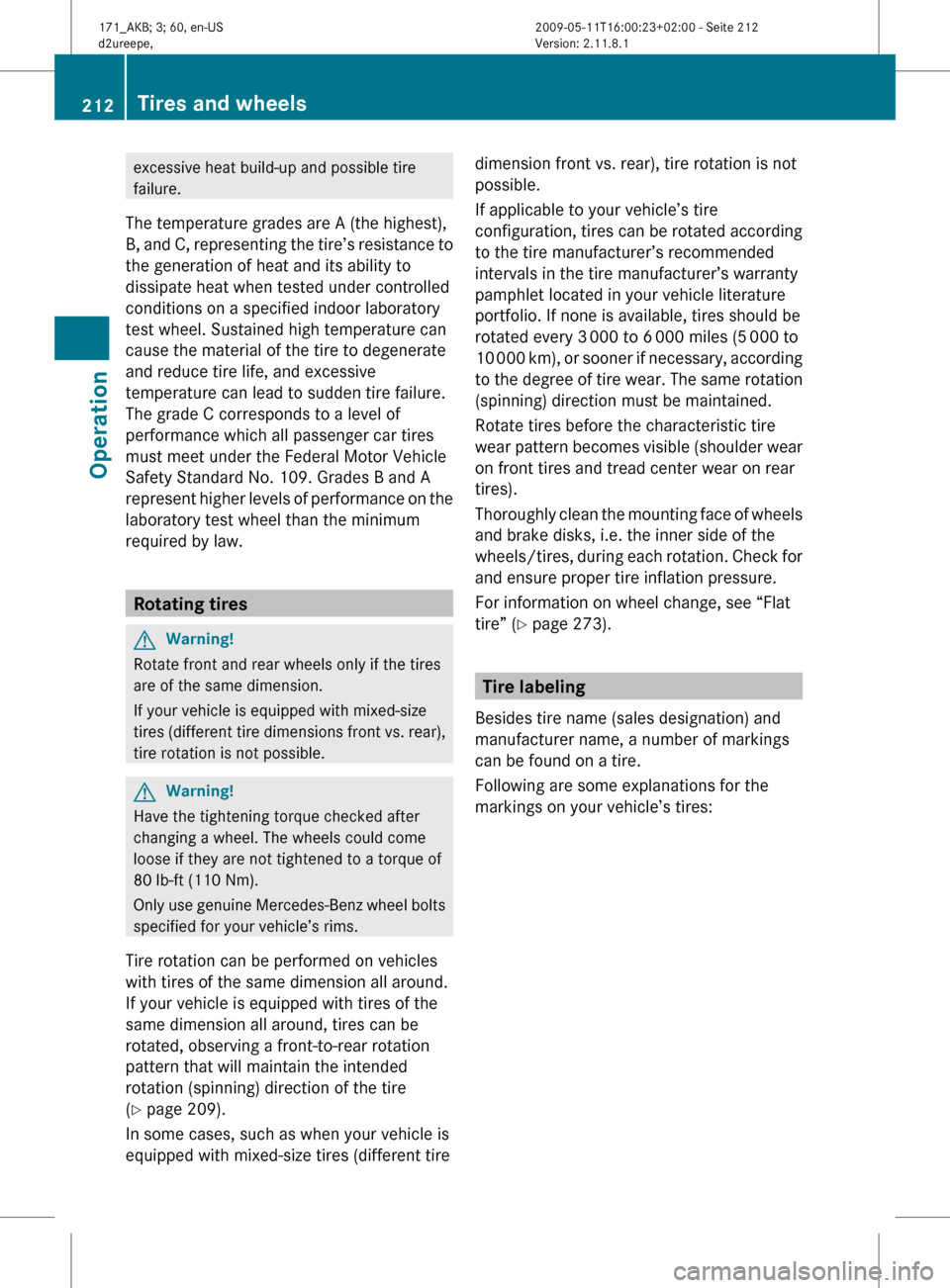2011 MERCEDES-BENZ SLK300 bolt pattern
[x] Cancel search: bolt patternPage 17 of 312

TIN (Tire Identification Number) ......
219
Tire and Loading Information
placard ............................................... 205
Tire and loading terminology ...........217
TIREFIT ............................................... 273
Tire Identification Number see TIN
Tire inflation pressure
Checking ........................................ 201
Important notes on ........................ 199
Label on the inside of fuel filler
flap ................................................ 200
Placard on driver’s door B-pillar ..... 205
Tire labeling ....................................... 212
Tire load rating .................................. 218
Tire ply composition and material
used .................................................... 219
Tire repair kit see TIREFIT
Tires ........................................... 197, 297
Advanced Tire Pressure
Monitoring System (Advanced
TPMS) ............................................ 201
Air pressure ................................... 198
Care and maintenance ................... 209
Cleaning ......................................... 210
Direction of rotation, spinning .......209
Important notes on tire inflation
pressure ........................................ 199
Inflation pressure .................. 200, 201
Information placard ....................... 205
Inspection ...................................... 209
Labeling ......................................... 212
Load index ............................. 213, 218
Load rating .................................... 218
Messages in the multifunction
display ................................... 241, 255
Ply composition and material
used ............................................... 219
Problems under-/overinflation ...... 200
Retreads ........................................ 197
Rims and tires (technical data) ...... 297
Rotation ......................................... 212
Service life ..................................... 210
Sizes .............................................. 297
Snow chains .................................. 220
Speed rating .......................... 214, 219
Storing ........................................... 210Temperature
.......................... 199, 211
Terminology ................................... 217
TIREFIT (tire repair kit) ................... 273
Tire Identification Number ............. 219
TPMS low tire pressure/
malfunction telltale .................. 26, 262
Traction ................................. 211, 219
Tread ............................................. 219
Tread depth ........................... 210, 219
Treadwear
...................................... 211
Treadwear indicators ............. 210, 219
Vehicle maximum load on ..............219
Wear pattern .................................. 212
Winter tires ............................ 219, 297
Tire speed rating .......................214, 219
Total load limit ................................... 219
Tow-away alarm .................................. 52
Towing
Towing eye bolt .............................. 286
Vehicle ........................................... 285
Towing eye bolt ................................. 286
Traction ...................................... 211, 219
Transmission see Automatic transmission or
Manual transmission
Transmission fluid level .................... 195
Transmission gear selector lever see Gear selector lever
Transmission positions ....................... 87
Traveling abroad ............................... 224
Tread (tires) ....................................... 219
Tread depth (tires) ....................210, 219
Treadwear .......................................... 211
Treadwear indicators (tires) .... 210, 219
Trip computer menu .........................109
Trip odometer, resetting ..................... 93
Trunk
Closing ............................................. 60
Messages in the multifunction
display ........................................... 245
Opening ........................................... 60
Trunk lid emergency release ............ 60
Unlocking manually .......................265
Valet locking .................................... 61
Turning off the engine ........................84
Turn signals ......................................... 73
Cleaning lenses ............................. 229 Index
15 171_AKB; 3; 60, en-US
d2ureepe,
Version: 2.11.8.1 2009-05-11T16:00:23+02:00 - Seite 15
Page 214 of 312

excessive heat build-up and possible tire
failure.
The temperature grades are A (the highest),
B,
and C, representing the tire’s resistance to
the generation of heat and its ability to
dissipate heat when tested under controlled
conditions on a specified indoor laboratory
test wheel. Sustained high temperature can
cause the material of the tire to degenerate
and reduce tire life, and excessive
temperature can lead to sudden tire failure.
The grade C corresponds to a level of
performance which all passenger car tires
must meet under the Federal Motor Vehicle
Safety Standard No. 109. Grades B and A
represent higher levels of performance on the
laboratory test wheel than the minimum
required by law. Rotating tires
G
Warning!
Rotate front and rear wheels only if the tires
are of the same dimension.
If your vehicle is equipped with mixed-size
tires
(different tire dimensions front vs. rear),
tire rotation is not possible. G
Warning!
Have the tightening torque checked after
changing a wheel. The wheels could come
loose if they are not tightened to a torque of
80 lb-ft (110 Nm).
Only
use genuine Mercedes-Benz wheel bolts
specified for your vehicle’s rims.
Tire rotation can be performed on vehicles
with tires of the same dimension all around.
If your vehicle is equipped with tires of the
same dimension all around, tires can be
rotated, observing a front-to-rear rotation
pattern that will maintain the intended
rotation (spinning) direction of the tire
(Y page 209).
In some cases, such as when your vehicle is
equipped with mixed-size tires (different tire dimension front vs. rear), tire rotation is not
possible.
If applicable to your vehicle’s tire
configuration, tires can be rotated according
to the tire manufacturer’s recommended
intervals in the tire manufacturer’s warranty
pamphlet located in your vehicle literature
portfolio. If none is available, tires should be
rotated every 3 000 to 6
000 miles (5 000 to
10 000
km), or sooner if necessary, according
to the degree of tire wear. The same rotation
(spinning) direction must be maintained.
Rotate tires before the characteristic tire
wear pattern becomes visible (shoulder wear
on front tires and tread center wear on rear
tires).
Thoroughly clean the mounting face of wheels
and brake disks, i.e. the inner side of the
wheels/tires, during each rotation. Check for
and ensure proper tire inflation pressure.
For information on wheel change, see “Flat
tire” ( Y page 273). Tire labeling
Besides tire name (sales designation) and
manufacturer name, a number of markings
can be found on a tire.
Following are some explanations for the
markings on your vehicle’s tires: 212
Tires and wheels
Operation
171_AKB; 3; 60, en-US
d2ureepe,
Version: 2.11.8.1 2009-05-11T16:00:23+02:00 - Seite 212